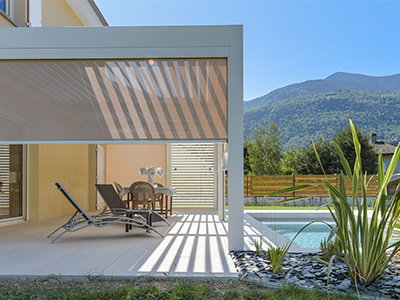My bioclimatic pergola has a water leak : How to react ?
You have just noticed that your bioclimatic pergola has a water leak. While this may not necessarily affect the operation of the pergola, this situation should alert you, here's how to react.
Differentiate between water leaks and perfect waterproofing for a bioclimatic pergola
First of all, it is important to remember that bioclimatic pergolas cannot be considered watertight in the legal sense of the term. Indeed, the notion of waterproofing is quite precise in the construction industry and stipulates that water should not pass through at all. This cannot be the case for the bioclimatic pergola, which, not being an enclosed structure, will always allow a few drops to pass through, especially in heavy rain showers. Nevertheless, a bioclimatic pergola will provide good rain protection.
Tests have even been conducted on Solisysteme pergolas by the CSTB (Scientific and Technical Center for Building) and have demonstrated good rainwater drainage of up to 230 mm/hour: see dedicated article.
Thus, even though bioclimatic pergolas cannot be qualified as watertight, they will still serve as a good barrier against rain.

What kind of water leak can I have on my bioclimatic pergola ?
Starting from the premise that a bioclimatic pergola is not watertight, it will be important to differentiate between the few drops that may fall between the slats (or at the gutter level) and a stream of water falling in quantity on your terrace.
If you observe that your terrace is regularly soaked in a specific area after a rain episode, do not hesitate to watch for a water leak during a new downpour. This will allow you to assess the amount of water escaping from the pergola's rainwater drainage system and identify the source of the leak. In the case of a regular and obvious water leak originating from the pergola itself, you can then proceed with some checks yourself.

How to react if I notice a water leak on my bioclimatic pergola ?
If you have observed a leak in a specific area of your pergola, start by carefully checking the source of the leak. Clean the pergola and clear the water evacuation areas. In many cases, it will be a buildup of leaves or twigs that has slipped between the slats and allows water to pass through. This thin stream of water may appear insignificant but can still release a significant amount of water if the rain episode is intense or prolonged.
In another case, it is possible that a buildup of impurities disrupts or even completely blocks a slat passage or gutter. With water no longer draining, it will overflow and cause a water leak under the installation. You can then remedy the problem yourself by cleaning your pergola and clearing the water evacuation areas. You should pay particular attention to cleaning the slat grooves, gutters, and chutes.
Once the entire system is cleared, you should no longer find any leaks. Check the amount of water reaching the pergola.
If all the drainage system is clear but the leak problem persists, this may also be due to the amount of water reaching your pergola. This problem is rarer, but a roof runoff or direct roof gutter drainage onto your pergola is not desirable. The amount of water to be drained will be too high for the pergola, which has not been designed for this purpose, and may cause leaks due to overflow. You will need to divert this roof water so that it no longer falls directly on your installation.
Contact your installer to describe the problem For all other leak cases not related to the previous scenarios, you will need to contact your installer to address the issue. Even if you think you have found the explanation by observing the installation yourself, do not attempt to intervene directly yourself or you may risk further damage to the installation or void the warranty.
Among the other explanations, a leak can be caused by:
- Wear of the seals, especially if your installation is several years old.
- A problem with the slope among the water drainage elements.
- A installation defect with poor jointing of parts, for example.
- Or even by a defect in the original part, which can occur despite the numerous quality control points.
An installer/manufacturer team at your service
in case of a defect
In summary, in the event of a leak under your bioclimatic pergola, some explanations will require maintenance on the installation, which can easily be carried out by you without the installer's intervention.
Others will be explained by the age of the installation, which, despite the quality of the materials, will also undergo degradation over time. These will be easily repairable and will not affect the pergola's durability.
And others will be related to manufacturing or installation and may unfortunately require more extensive interventions.

In either case, your installer will be able to intervene with the support of Solisysteme technicians directly or indirectly if necessary. Want to learn more about our bioclimatic pergolas? Do not hesitate to consult our website or contact us for more information.



















